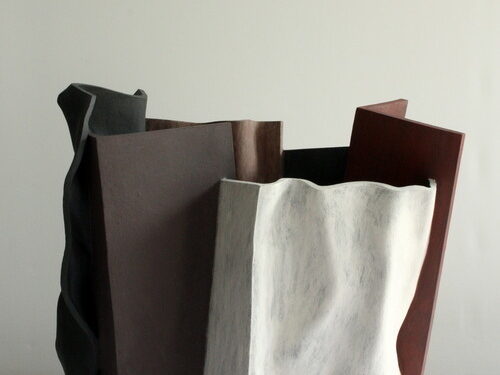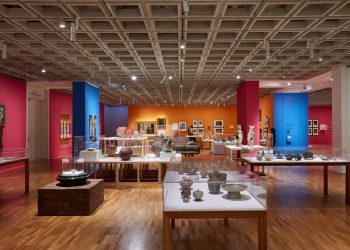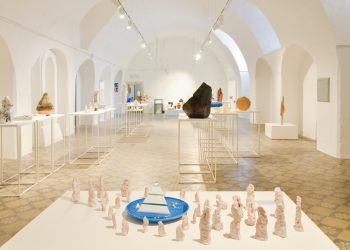
Why did you choose the vessel as the central element of your art? Was there a transition from functional vessels to sculptural ones?
I have been working in ceramics continually since 1980. There have been periods when I have moved away from the vessel, but really it has been at the core of my work for most of the time since then. I do not make functional pots, but rather use the vessel as a subject – to give meaning and form to an expression. For a long time now I have realised that my overriding interest is making new coloured clay forms. This seems for me to be the essence of pottery- to make shapes which occupy and contain space and to decorate those shapes. By decorate, I mean to paint slip or glaze, to draw, to make image or line across the skin of the clay.
Does your creative process start from a certain image in your mind, or do you seek for inspiration as you progress?
I have always made things – at first out of Lego and wood and for a long time now, using clay. Working on how to approach creating, so that I can go to work every day and explore shape and colour and move forwards, is always hard. The breadth of ceramic possibilities means that to make any progress it is necessary to build up some strict limitations. I use writing and drawing to approach the spirit of a piece of work, but I do not draw an ‘architectural plan’ of the piece that I am about to make: ideas that work in two dimensions are often different from those that are successful in three dimensions. Also, if I knew exactly what I was going to make before I started work in clay, there would be little room left for the play and invention that is an essential part of creative work. A large part of the reason for making is to see things which I have never seen before – to build something which I am excited about and wish to show and share with others. So I try not to plan anything except roughly how to proceed within my imposed limitations.
Tell us about the slab building technique that you use. What are the challenges that you encounter and the skills that it requires?
I roll out slabs of white stoneware clay by hand with a wooden rolling pin. Most of the rolling is bashing the clay flat, and the rolling smoothens the material towards the end of the process. From the moment I start rolling out slabs I have to start making decisions – not what the piece will look like, which will in time become clear, but the details – how wide, how long, how thin or thick the slab, choices which determine shape. The objects that I make are clearly defined, they have drawn ground plans, smooth walls and clear edges, but this resolution emerges slowly. There are certain curves and curlings that a thin slab can manage better than a thicker one, but sometimes it’s the soft fatness of a rim or the weight of a piece that is more important.
Colour is an important part of your work. How do you see the interaction between colour and volume?
As soon as possible in the making process, I begin to make marks on the surface with coloured slips and oxides, whilst the clay is still quite wet. I paint on numerous layers of colour, firing the work repeatedly. I apply it in response to three-dimensional form, and it is in this way I paint the surface in order to explore and make sense of what I have made. I don’t know what colour I want a piece to be until I find it by working – building up layers of colour can often feel more like a stripping away to reveal what was meant. I am interested in the relationship between colour, the illusionistic space of a surface and actual space. This relationship is a complex one – as well as inhabiting the two-dimensional space on a curving plane of clay, colour can, in a sense fill the actual 3 dimensional space of the vessel itself. Glen Brown in writing about my work said that colour becomes “volumetric, contained, like real space itself, by the vessel walls rather than merely carried on them: it becomes a fundamental content of the work rather than a superficial aspect of it.”
Today’s contemporary art puts a lot of emphasis on dynamics and interactivity. In this context, what is the merit of an artwork that encourages contemplation as an aesthetic experience?
Being a static artwork does not exempt it from being dynamic or profound. Artwork which is three dimensional demands that the viewer moves around the work and becomes involved in order to experience it and to contemplate it, which is, of course, a truly dynamic and interactive experience.

Ken Eastman: Hold your own, Stoneware with painted coloured slips and oxides, 38 x 33 x 54 cm. The Cover of Ceramics Now Magazine, Issue 2.
Ceramics is one of the most complex arts, being at the meeting point of sculpture and painting, graphics and design, utilitarian and non-utilitarian. And yet, why aren’t ceramic artists more present on the contemporary art scene, and in the mind of the majority of the public?
I think it is possible to ask the same question about numerous other disciplines and specialities – right across the arts, literary, musical and visual. The majority of arts activity is not acknowledged by celebrity culture except for a very few names that repeatedly recur across the media. Furthermore the particular profile of the ceramics arts has experienced profound change in recent years (in the UK and Europe) due partly to changes in Secondary and Higher Education policies. But this situation is changing all the time and it is not mirrored everywhere else either;in many places in the world the ceramic arts are highly respected.
You are a well-known figure in the field of ceramics and an inspiration for many young artists. What are the artists that influenced and inspired you at the beginning of your career?
When I began making ceramics in 1980 I was initially inspired by the material itself – it seemed so open and abstract, so simple and so difficult at the same time. I soon realized you could build pots, sculptures, houses, teeth, basins, sparkplugs, anything was possible; I found that very exciting. At that time I was inspired by the ambition, scale and energy of the US ceramic artists such as Voulkos, Turner, Frey and Autio, but I probably spent much more time looking at twentieth century painting.
What advice would you give to a young artist? Why should one consider ceramics as the right medium for expressing ideas?
Clay is cheap and abundant and covers most of the surface of the earth. The language of building with clay and making ceramics is a universal language, common to all cultures. This is not a precious material neither is ceramics a rarified activity for an interested few. It is commonplace, it is part of all of our lives and relevant to everyone- that’s a good start! Practice, keep making and keep exhibiting, and trust your eyes and your intuition.
Interview by Ileana Surducan, published in Ceramics Now Magazine, Issue 2.
Visit Ken Eastman’s website.



















